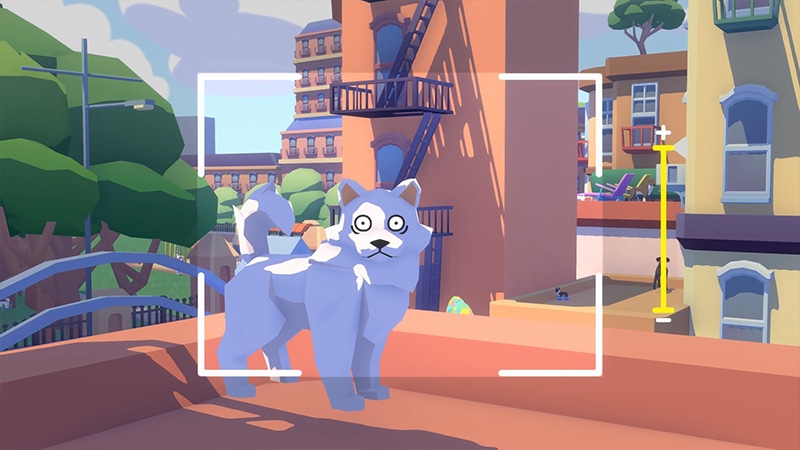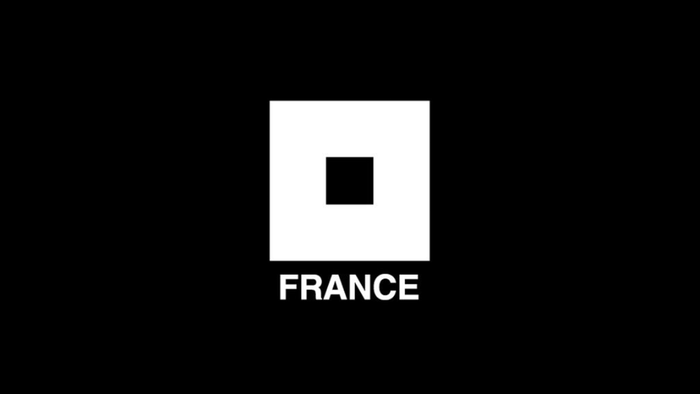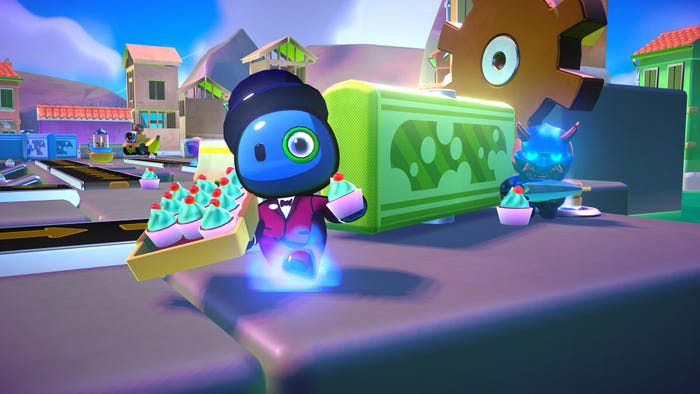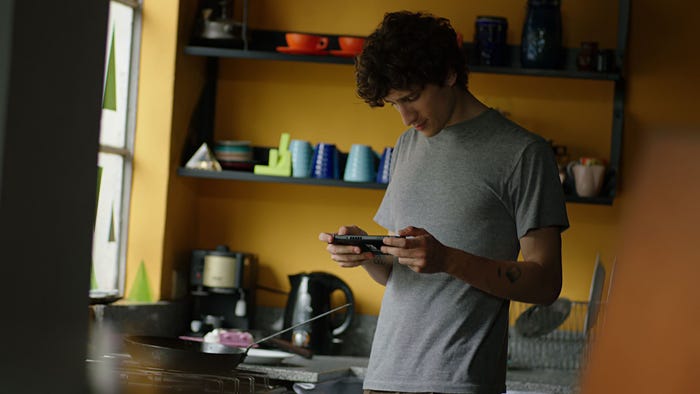Bokeh fur.

Pet the dog. Play fetch with the dog. Take photos of the dog. Explore a world populated entirely by DOGS. That's the simple and impossibly alluring premise behind Pupperazzi, a canine-stuffed photography title that proves heaven really is a place on earth (we just didn't know it'd take the form of a video game).
The beautiful, furry brainchild of developer Sundae Month, Pupperazzi drops players into a pure, untainted universe where dogs have somehow become the dominant species. In this wholesome alternate reality, players are tasked with finding their canine comrades' best angles and becoming the finest, most in-demand freelance pupperazzo in history.
We suspect you'd be hard-pressed to find anyone who doesn't agree Pupperazzi sounds like a fantastic prospect on-paper, but how did Sundae Month turn that barking mad concept into a reality? We caught up with Isobel Shasha (lead developer), Campbell Fletcher (lead artist), Christie McCown (dog artist), Fisher Wagg (writing, level and mission design) and Ben Sironko (programmer) to find out.
As a concept, Pupperazzi feels like an easy sell. Take shots of cute and quirky canines and become a star photographer. But I'm curious to know how that initial elevator pitch evolved as you sought to add tangible mechanics and find the fun?
Isobel Shasha: It evolved a lot. I think we fully redesigned the core loop of the game from scratch 5 or 6 times. Early on we knew there would be characters requesting photos with specific criteria, but my early game loop designs ended up sort of strangled in cumbersome UI. As team lead, looking back I think I underestimated the amount of pre-production any game needs. It got very difficult by the time we were about halfway through development, with all the pieces there but the overall user experience still not clicking. In the home stretch of the design though, we were able to analyze it from a UX perspective and make a big pivot to a design that allowed the player to seamlessly progress through the game without leaving the dogs to navigate through menus.
I've also been wondering if there were any mechanics or ideas that got left on the cutting room floor as you iterated during production?
Isobel Shasha: The original prototype for the game was an arcadey local multiplayer experience. For a long time we wanted to preserve multiplayer, but ultimately it just got too complicated as we basically had to develop two games alongside each other. A lot of the technical systems in the game are deceptively complex, so unfortunately it just ultimately wasn't possible.
Fisher Wagg: A surprising amount of what we wanted to put in the game did make it in though. For instance, even though we significantly pared down the dialogue systems, we still have an entire series of missions and unlockable areas. We have an entire level that started as a half-joke and somehow we made time to bring it to life. The biggest cut was definitely multiplayer for which I shed a small tear every day, but we also ended up cutting a lot of the social media aspects as well. We had some plans for a small scale internet and much more involved social interactions. We also had some interesting pitches for story directions that would have been somewhat darker and more subversive, and while I wouldn't say those are completely cut out, the tone of the game is significantly lighter than the earliest pitches.
Campbell Fletcher: Just want to say that one of the multiplayer game modes we tested included one player taking the role of a dog. Trying to run away, hide among other dogs, and ultimately give into posing for the camera was so so fun.

In order to find the perfect angle, players will need to run, jump, and interact with the world. What was the thought process behind adding those traversal and interaction mechanics, and how did they evolve during development?
Isobel Shasha: We honestly thought it would be funny to juxtapose the photography mechanics with more of an action-oriented control scheme. For a while I tried to make a parkour mechanic work too, but that fortunately got cut. Really we couldn't help but make the levels big and interesting to explore, in the hopes that it would be satisfying on its own, as well as give more angles and places to take photos from.
I was also wondering if you'd be able to break down the photography mechanics in Pupperazzi? How did you make the act of taking pictures - which is something pretty much everyone with a smartphone does these days - consistently engaging without alienating players with too much complexity?
Fisher Wagg Early on in development we knew this game would be attractive to casual players. We had several examples of photography games on consoles that had different levels of interactivity and we took some inspiration from there. A pattern photography games seem to have is that they tend to feel fairly static. One approach to the genre we really wanted was to have vastly more interactive areas, but time constraints proved to be an issue. Another approach was to flesh out the mission submission process to be more like a virtual internet exploratory game somewhat like Hypnospace Outlaw, but again, the time constraints. We find what I think is a pretty happy middle, where completing missions makes changes to the world that feel rewarding and progressive. We want the player to feel like they play a role in the NPC community and engage with that element of roleplay a bit, and that really helps the world feel very returnable I think.
We focus less on the technical aspects of the players shots and more on asking the player to engage with their own creative goals. That's not to say that each mission is so loosely defined as to be nonexistent, but more to say that photos submitted to our virtual "social network" receive open ended feedback that can help players come to their own creative decisions.
We also have simplified controls as an option for players who have trouble with (or want to focus less on) movement. We want this game (and all games really) to be accessible for as many people as possible.

How did you ensure the world of Muttropolis its furry residents would be unbearably photogenic? Could you outline your approach to character design and level design through that lens?
Christie McCown: As for character design, we wanted to keep the shapes simple and stylized for readability -- it was important that people see the things they love about different dogs in our models. a clear silhouette that captures a particular breed's iconic features helps not only makes them recognizable but photogenic as well!
Fisher Wagg: With level design variety was a big focus. Beyond the missions we set up, we don't know what sort of photos the player will want to take. We tried to have areas with different light qualities and geometric features always nearby. For example even on the brightly lit beach, you can turn around and find yourself under the dark boardwalk and get a completely different vibe to your shots. In a lot of ways it's similar to designing areas for sandbox games (like Garry's Mod) in that you want to have lots of opportunity for play and give players easy access to what you think they might want to play with. And also like all the best Garry's Mod maps, secrets help a lot.
Campbell Fletcher: Most importantly, we began testing our photo quality from the beginning. It's easy to collect good playtest data when every photo you take is saved to a shared drive!
Our dogs were photogenic from the start, but they didn't always act like it -- running too fast, hopping out of frame, looking away, and having way too many friends around them or in the background all seemed to ruin even the best photographer's work. "Good Boy" AI changes did a great job fixing these issues!
Sadly, Greyboxing or concept painting alone can't prove your levels will have good composition in photos, so we had to start iterating on environment art very early too. Modular assets are definitely crucial for photo games. We also found that if spaces are hugely open, there will be too much noisy content in a single photo. Adding medium/large size environment chunks to obscure the longest views makes sure there will always be a good backdrop for your subjects, and exciting corners for the player to turn.
We hand-placed some dogs sitting in cute and funny places to guarantee some perfect photos, but the breed or what they're wearing is somewhat random, so there are always new opportunities. And while we do plan out many potential shots the player could take, the combination of non-linear levels and free-willed wandering dogs never stops creating moments of "environmental storytelling" that are completely unplanned!

I know you're not supposed to have favourites, but is there a specific pupper you're particularly proud of? A canine that's a cut above the rest because of the sheer amount of effort it took to get them in the game? If so, could you talk about the trials and tribulations that went into realising that particular pooch?
Christie McCown: I wouldn't say any of them were harder to make than the others, but I'm particularly fond of the beagle since my childhood pups were all beagles.
Campbell Fletcher: It was definitely hard to fit collars and accessories on the floofy dogs (samoyed and pomeranian), but in the end we made them all work really well. And similarly I love the dachshund, which is modeled to look like my dog.
Adding over 200 total color variations for our dogs meant researching what color coats exist and how rare they are in "nature", though there is no universal resource for this information across all breeds. It was an almost absurd dedication to accuracy, but it's been completely worth it as people have already started noticing their own dogs in the game, or their favorite game pups in real life! and don't worry -- the very rarest dogs are a bit more far-fetched.
Photography games seems to be experiencing something of a revival, with titles like TOEM and New Pokemon Snap generating a fair bit of buzz. What's the biggest lesson you've learned working in the genre? Something you wish you'd know when you embarked on the journey, that might prove useful to other devs looking to do the same?
Isobel Shasha: A deep photography mechanic is very technically challenging, because the human eye is very good at recognizing content of an image, but computers can't do it. I think it's part of why captchas make you identify parts of images to prove you're human. We definitely knew this going in, and discussed it a lot, but unfortunately we didn't spend enough time planning, testing, and iterating the underlying photo tech.
Instead we just threw a lot of feature requests at Ben as the design evolved to require different things from the photo tag system. So we ended up with some features that were difficult to get working that aren't used, and other features that are important that are under-tested. Most of the bugs we're still fixing at the end of production are related to the accuracy of photo content recognition. So the lesson is just: slow down, and invest your time into making the underlying tech simple and strong and easy to work with.
Ben Sironko: My advice for working on a photography game is to figure out the surrounding game before most of the photo tech is spun up. Just get a simple image generation system working and use human evaluation of photos against whatever game design you're playtesting. This will give you a better idea of what kinds of photos players will take and what kinds you want them to take and you can build an extremely solid and reasonably flexible system around those elements.
We made the mistake of trying to build an elaborate, robust system WHILE the game design was still in flux. Every time the design evolved and core values changed, we had to figure out how to shoehorn the new requirements into this increasingly complex system. And while we're getting a handle on it now, it caused way too many avoidable headaches throughout the development cycle. Ultimately photo detection is more rooted in design than I think anybody embarking on a photography game realizes. The dream of a Totally Robust Detection System is kind of a White Whale; there are just lots of reasonably robust possibilities depending on the needs of the rest of the game.
Read more about:
FeaturesAbout the Author(s)
You May Also Like








